Renovation of Royale Pizza Shop | Study
VerifiedAdded on 2022/09/09
|14
|2802
|34
AI Summary
Contribute Materials
Your contribution can guide someone’s learning journey. Share your
documents today.
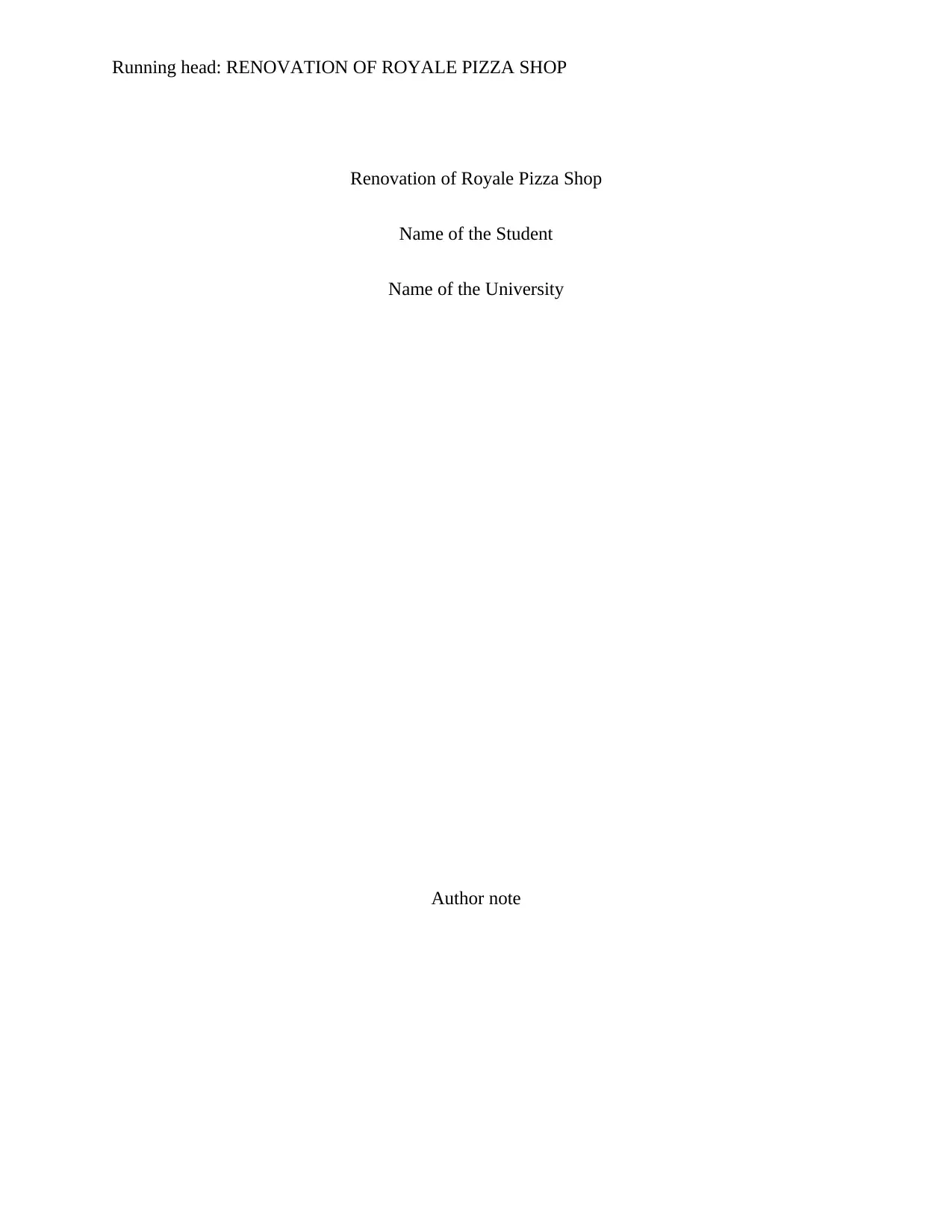
Running head: RENOVATION OF ROYALE PIZZA SHOP
Renovation of Royale Pizza Shop
Name of the Student
Name of the University
Author note
Renovation of Royale Pizza Shop
Name of the Student
Name of the University
Author note
Secure Best Marks with AI Grader
Need help grading? Try our AI Grader for instant feedback on your assignments.
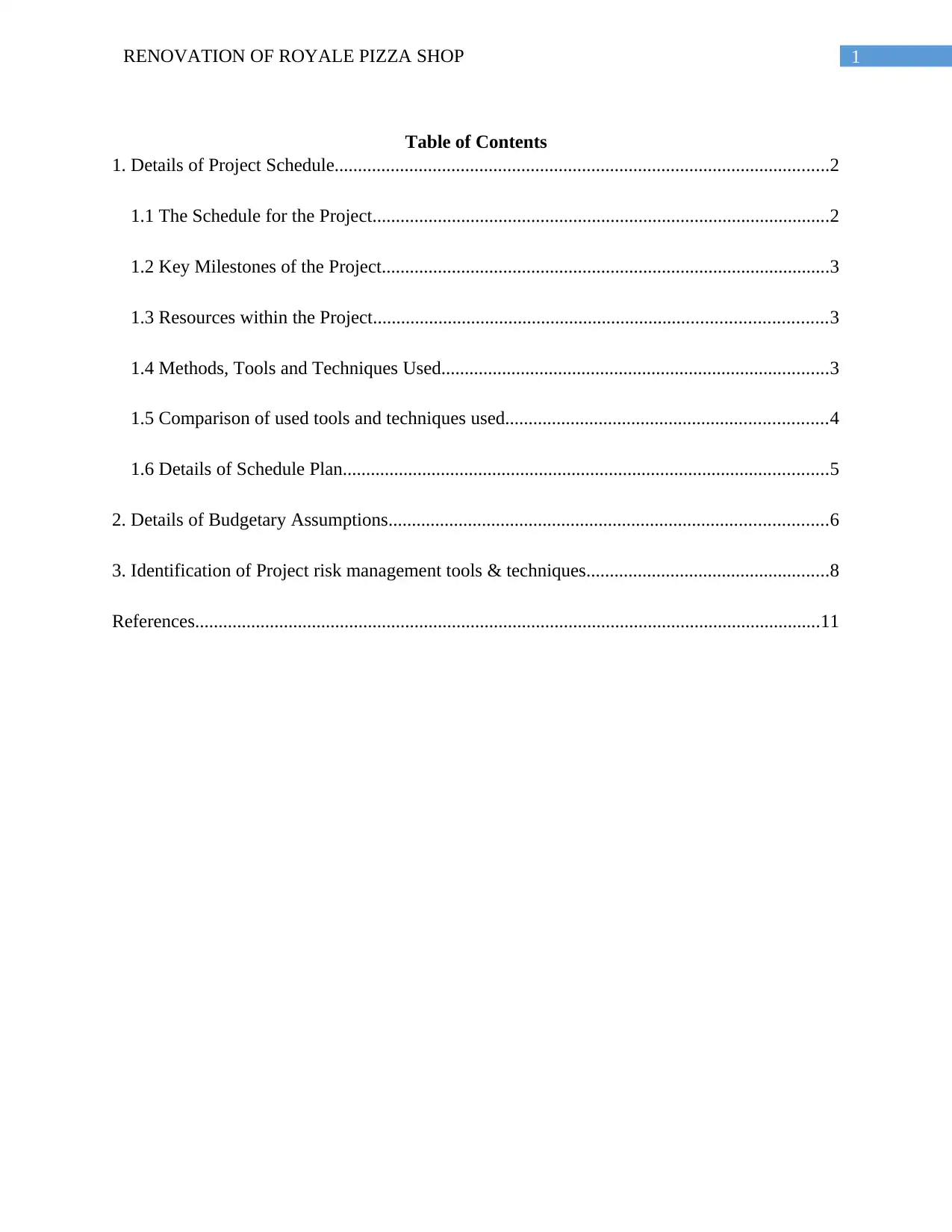
1RENOVATION OF ROYALE PIZZA SHOP
Table of Contents
1. Details of Project Schedule..........................................................................................................2
1.1 The Schedule for the Project..................................................................................................2
1.2 Key Milestones of the Project................................................................................................3
1.3 Resources within the Project.................................................................................................3
1.4 Methods, Tools and Techniques Used...................................................................................3
1.5 Comparison of used tools and techniques used.....................................................................4
1.6 Details of Schedule Plan........................................................................................................5
2. Details of Budgetary Assumptions..............................................................................................6
3. Identification of Project risk management tools & techniques....................................................8
References......................................................................................................................................11
Table of Contents
1. Details of Project Schedule..........................................................................................................2
1.1 The Schedule for the Project..................................................................................................2
1.2 Key Milestones of the Project................................................................................................3
1.3 Resources within the Project.................................................................................................3
1.4 Methods, Tools and Techniques Used...................................................................................3
1.5 Comparison of used tools and techniques used.....................................................................4
1.6 Details of Schedule Plan........................................................................................................5
2. Details of Budgetary Assumptions..............................................................................................6
3. Identification of Project risk management tools & techniques....................................................8
References......................................................................................................................................11

2RENOVATION OF ROYALE PIZZA SHOP
1. Details of Project Schedule
1.1 The Schedule for the Project
ID Outline
Number
Task
Mode
Task Name Duration Start Finish
0 0 Renovation Project of
Royale Pizza Shop
117 days Fri 01-03-19 Mon
12-08-19
1 1 Start Project 0 days Fri 01-03-19 Fri 01-03-19
2 2 Design of the Project 27 days Fri 01-03-19 Mon 08-04-19
3 2.1 Surveying the present
shop condition
3 days Fri 01-03-19 Tue 05-03-19
4 2.2 Defining the floor
plans and inclusions
of shop
12 days Wed 06-03-19 Thu 21-03-19
5 2.3 Designing of the
renovation plan
12 days Fri 22-03-19 Mon 08-04-19
6 2.4 Approval for the
renovation plan
0 days Mon 08-04-19 Mon 08-04-19
7 3 Procurement and
Delivery
37 days Tue 09-04-19 Wed
29-05-19
8 3.1 Preparing a list of
items for
procurement
5 days Tue 09-04-19 Mon 15-04-19
9 3.2 Approval for budget 0 days Mon 15-04-19 Mon 15-04-19
10 3.3 Purchase of new
equipment
15 days Tue 16-04-19 Mon 06-05-19
11 3.4 Delivery of materials 12 days Tue 07-05-19 Wed 22-05-19
12 3.5 Checking the
materials and sorting
5 days Thu 23-05-19 Wed 29-05-19
13 4 Construction of the Shop 37 days Tue 07-05-19 Wed 26-06-19
14 4.1 Flooring works within
the shop
4 days Thu 30-05-19 Tue 04-06-19
15 4.2 Determining the
spaces in which the
materials would be
set up
3 days Tue 07-05-19 Thu 09-05-19
16 4.3 Renovation works
over the shop
9 days Wed 05-06-19 Mon 17-06-19
17 4.4 Removal of stairs 7 days Fri 10-05-19 Mon 20-05-19
18 4.5 Development of
additional dining
spaces
7 days Tue 18-06-19 Wed 26-06-19
19 5 Installation and Painting 33 days Thu 27-06-19 Mon 12-08-19
20 5.1 Installation of AC
System
2 days Thu 27-06-19 Fri 28-06-19
21 5.2 Performing dust-free
painting
16 days Mon 01-07-19 Mon 22-07-19
22 5.3 Increasing the
capacity of
compressor
4 days Mon 01-07-19 Thu 04-07-19
23 5.4 Cleaning of kitchen
exhaust system
10 days Tue 23-07-19 Mon 05-08-19
24 5.5 Installation of
hardware and
software systems
5 days Tue 06-08-19 Mon 12-08-19
25 6 End Project 0 days Mon 12-08-19 Mon 12-08-19
01-03
PM Consultant,Technical Manager
Technical Manager
Technical Manager
08-04
PM Consultant,Technical Manager
15-04
Chairs and Tables[1],Equipment[1],Hardware and Software[1]
Equipment Supplier
Technical Manager
Contractor
Contractor
Contractor
Contractor
Contractor
Installers
Contractor
Installers
Contractor
Installers,Technical Manager
12-08
T W T F S S M T W T F S S
27 Jan '19 03 Mar '19 07 Apr '19 12 May '19 16 Jun '19 21 Jul '19 25 Aug '19
(Figure 1: The Gantt chart for the project)
1. Details of Project Schedule
1.1 The Schedule for the Project
ID Outline
Number
Task
Mode
Task Name Duration Start Finish
0 0 Renovation Project of
Royale Pizza Shop
117 days Fri 01-03-19 Mon
12-08-19
1 1 Start Project 0 days Fri 01-03-19 Fri 01-03-19
2 2 Design of the Project 27 days Fri 01-03-19 Mon 08-04-19
3 2.1 Surveying the present
shop condition
3 days Fri 01-03-19 Tue 05-03-19
4 2.2 Defining the floor
plans and inclusions
of shop
12 days Wed 06-03-19 Thu 21-03-19
5 2.3 Designing of the
renovation plan
12 days Fri 22-03-19 Mon 08-04-19
6 2.4 Approval for the
renovation plan
0 days Mon 08-04-19 Mon 08-04-19
7 3 Procurement and
Delivery
37 days Tue 09-04-19 Wed
29-05-19
8 3.1 Preparing a list of
items for
procurement
5 days Tue 09-04-19 Mon 15-04-19
9 3.2 Approval for budget 0 days Mon 15-04-19 Mon 15-04-19
10 3.3 Purchase of new
equipment
15 days Tue 16-04-19 Mon 06-05-19
11 3.4 Delivery of materials 12 days Tue 07-05-19 Wed 22-05-19
12 3.5 Checking the
materials and sorting
5 days Thu 23-05-19 Wed 29-05-19
13 4 Construction of the Shop 37 days Tue 07-05-19 Wed 26-06-19
14 4.1 Flooring works within
the shop
4 days Thu 30-05-19 Tue 04-06-19
15 4.2 Determining the
spaces in which the
materials would be
set up
3 days Tue 07-05-19 Thu 09-05-19
16 4.3 Renovation works
over the shop
9 days Wed 05-06-19 Mon 17-06-19
17 4.4 Removal of stairs 7 days Fri 10-05-19 Mon 20-05-19
18 4.5 Development of
additional dining
spaces
7 days Tue 18-06-19 Wed 26-06-19
19 5 Installation and Painting 33 days Thu 27-06-19 Mon 12-08-19
20 5.1 Installation of AC
System
2 days Thu 27-06-19 Fri 28-06-19
21 5.2 Performing dust-free
painting
16 days Mon 01-07-19 Mon 22-07-19
22 5.3 Increasing the
capacity of
compressor
4 days Mon 01-07-19 Thu 04-07-19
23 5.4 Cleaning of kitchen
exhaust system
10 days Tue 23-07-19 Mon 05-08-19
24 5.5 Installation of
hardware and
software systems
5 days Tue 06-08-19 Mon 12-08-19
25 6 End Project 0 days Mon 12-08-19 Mon 12-08-19
01-03
PM Consultant,Technical Manager
Technical Manager
Technical Manager
08-04
PM Consultant,Technical Manager
15-04
Chairs and Tables[1],Equipment[1],Hardware and Software[1]
Equipment Supplier
Technical Manager
Contractor
Contractor
Contractor
Contractor
Contractor
Installers
Contractor
Installers
Contractor
Installers,Technical Manager
12-08
T W T F S S M T W T F S S
27 Jan '19 03 Mar '19 07 Apr '19 12 May '19 16 Jun '19 21 Jul '19 25 Aug '19
(Figure 1: The Gantt chart for the project)
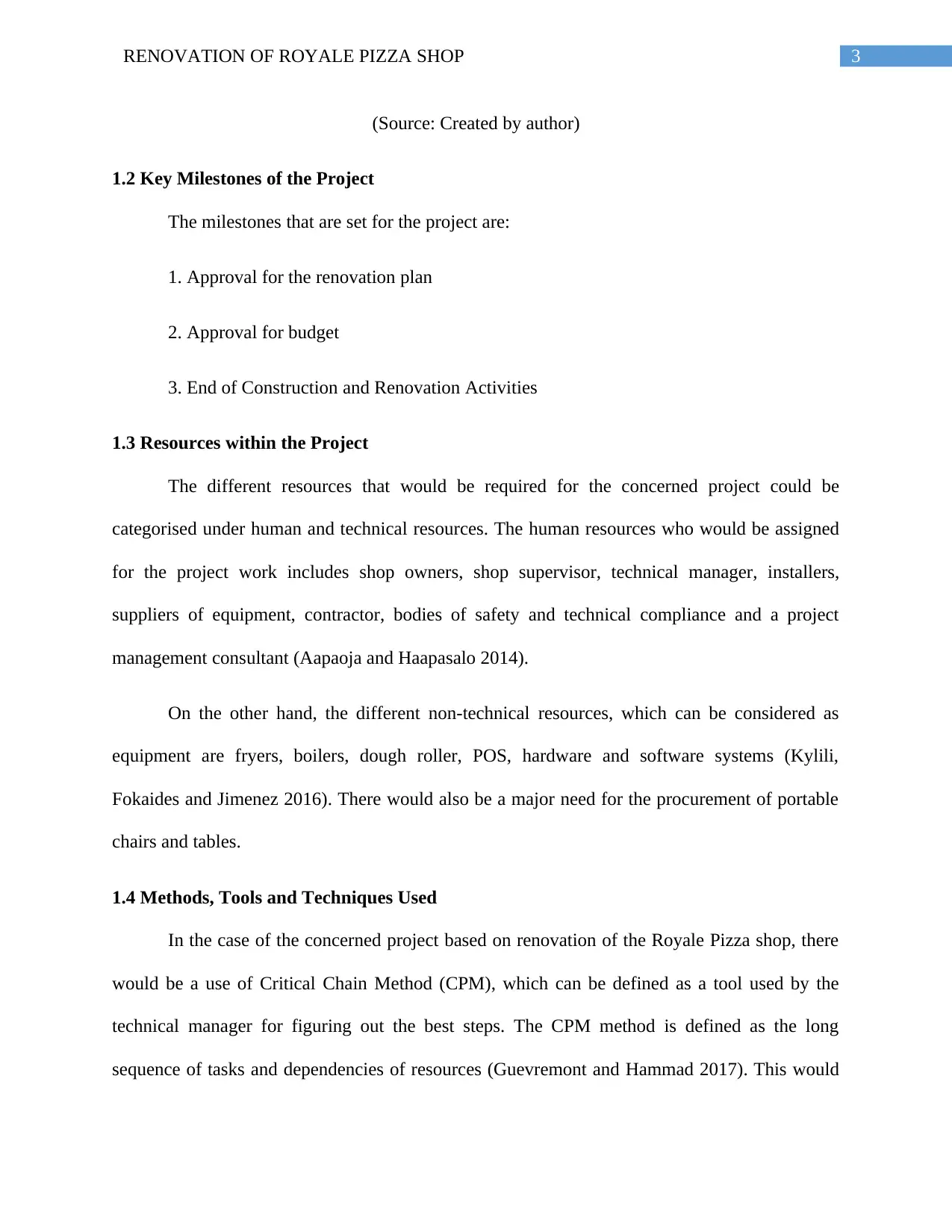
3RENOVATION OF ROYALE PIZZA SHOP
(Source: Created by author)
1.2 Key Milestones of the Project
The milestones that are set for the project are:
1. Approval for the renovation plan
2. Approval for budget
3. End of Construction and Renovation Activities
1.3 Resources within the Project
The different resources that would be required for the concerned project could be
categorised under human and technical resources. The human resources who would be assigned
for the project work includes shop owners, shop supervisor, technical manager, installers,
suppliers of equipment, contractor, bodies of safety and technical compliance and a project
management consultant (Aapaoja and Haapasalo 2014).
On the other hand, the different non-technical resources, which can be considered as
equipment are fryers, boilers, dough roller, POS, hardware and software systems (Kylili,
Fokaides and Jimenez 2016). There would also be a major need for the procurement of portable
chairs and tables.
1.4 Methods, Tools and Techniques Used
In the case of the concerned project based on renovation of the Royale Pizza shop, there
would be a use of Critical Chain Method (CPM), which can be defined as a tool used by the
technical manager for figuring out the best steps. The CPM method is defined as the long
sequence of tasks and dependencies of resources (Guevremont and Hammad 2017). This would
(Source: Created by author)
1.2 Key Milestones of the Project
The milestones that are set for the project are:
1. Approval for the renovation plan
2. Approval for budget
3. End of Construction and Renovation Activities
1.3 Resources within the Project
The different resources that would be required for the concerned project could be
categorised under human and technical resources. The human resources who would be assigned
for the project work includes shop owners, shop supervisor, technical manager, installers,
suppliers of equipment, contractor, bodies of safety and technical compliance and a project
management consultant (Aapaoja and Haapasalo 2014).
On the other hand, the different non-technical resources, which can be considered as
equipment are fryers, boilers, dough roller, POS, hardware and software systems (Kylili,
Fokaides and Jimenez 2016). There would also be a major need for the procurement of portable
chairs and tables.
1.4 Methods, Tools and Techniques Used
In the case of the concerned project based on renovation of the Royale Pizza shop, there
would be a use of Critical Chain Method (CPM), which can be defined as a tool used by the
technical manager for figuring out the best steps. The CPM method is defined as the long
sequence of tasks and dependencies of resources (Guevremont and Hammad 2017). This would
Paraphrase This Document
Need a fresh take? Get an instant paraphrase of this document with our AI Paraphraser
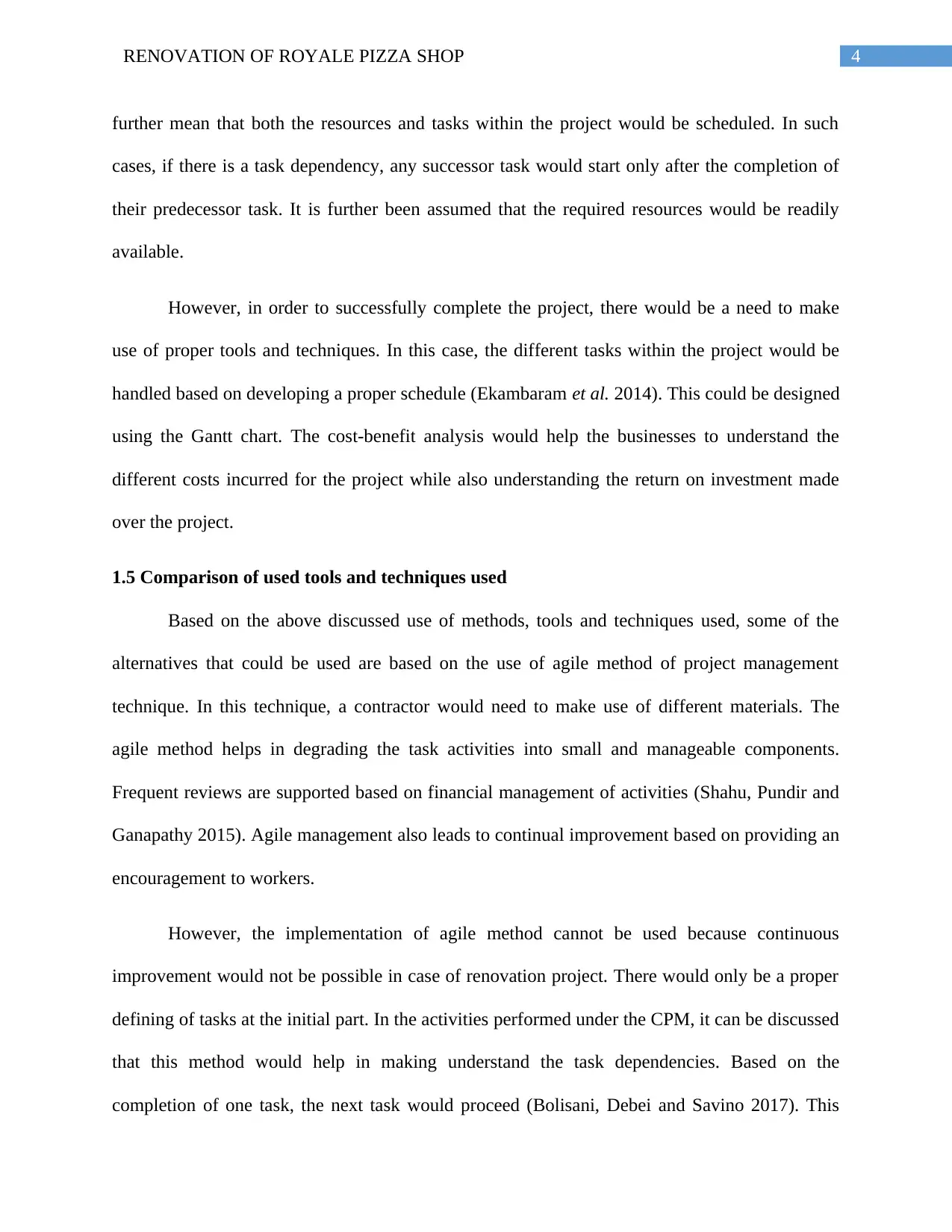
4RENOVATION OF ROYALE PIZZA SHOP
further mean that both the resources and tasks within the project would be scheduled. In such
cases, if there is a task dependency, any successor task would start only after the completion of
their predecessor task. It is further been assumed that the required resources would be readily
available.
However, in order to successfully complete the project, there would be a need to make
use of proper tools and techniques. In this case, the different tasks within the project would be
handled based on developing a proper schedule (Ekambaram et al. 2014). This could be designed
using the Gantt chart. The cost-benefit analysis would help the businesses to understand the
different costs incurred for the project while also understanding the return on investment made
over the project.
1.5 Comparison of used tools and techniques used
Based on the above discussed use of methods, tools and techniques used, some of the
alternatives that could be used are based on the use of agile method of project management
technique. In this technique, a contractor would need to make use of different materials. The
agile method helps in degrading the task activities into small and manageable components.
Frequent reviews are supported based on financial management of activities (Shahu, Pundir and
Ganapathy 2015). Agile management also leads to continual improvement based on providing an
encouragement to workers.
However, the implementation of agile method cannot be used because continuous
improvement would not be possible in case of renovation project. There would only be a proper
defining of tasks at the initial part. In the activities performed under the CPM, it can be discussed
that this method would help in making understand the task dependencies. Based on the
completion of one task, the next task would proceed (Bolisani, Debei and Savino 2017). This
further mean that both the resources and tasks within the project would be scheduled. In such
cases, if there is a task dependency, any successor task would start only after the completion of
their predecessor task. It is further been assumed that the required resources would be readily
available.
However, in order to successfully complete the project, there would be a need to make
use of proper tools and techniques. In this case, the different tasks within the project would be
handled based on developing a proper schedule (Ekambaram et al. 2014). This could be designed
using the Gantt chart. The cost-benefit analysis would help the businesses to understand the
different costs incurred for the project while also understanding the return on investment made
over the project.
1.5 Comparison of used tools and techniques used
Based on the above discussed use of methods, tools and techniques used, some of the
alternatives that could be used are based on the use of agile method of project management
technique. In this technique, a contractor would need to make use of different materials. The
agile method helps in degrading the task activities into small and manageable components.
Frequent reviews are supported based on financial management of activities (Shahu, Pundir and
Ganapathy 2015). Agile management also leads to continual improvement based on providing an
encouragement to workers.
However, the implementation of agile method cannot be used because continuous
improvement would not be possible in case of renovation project. There would only be a proper
defining of tasks at the initial part. In the activities performed under the CPM, it can be discussed
that this method would help in making understand the task dependencies. Based on the
completion of one task, the next task would proceed (Bolisani, Debei and Savino 2017). This

5RENOVATION OF ROYALE PIZZA SHOP
would better help in management of each of the task activities and also ensure successful
delivery of better outcomes.
1.6 Details of Schedule Plan
The detailing of the schedule plan for the Renovation project are:
1. Design of the Project – In this phase of the schedule, the present condition of the shop
would be surveyed. The floor plans and the necessary inclusions within the shop would be
defined and variations would be made. The renovation plan should be designed accordingly
based on the needs of the present business. After the renovation plan would be defined and
approved, the next phase of the project would begin.
2. Procurement and Delivery – After the plan of the project would be approved, the list
of items that would be needed would be procured. The budget would need to be approved based
on procuring each of the items. The equipment would be purchased and then it would be
delivered to the location. Each of the materials would be checked and sorted accordingly based
on understanding whether each of the materials have been procured as per the needs of
renovation.
3. Construction of the Shop – In the initial phase of this project, the works of flooring
would be done. The particular spaces would be provided in which the materials would be set up
(Jensen and Maslesa 2015). However, there would be a certain stage in which there would be a
removal of stairs based on providing more space for food preparation.
4. Installation and Painting – After the stairs at the rear side would be removed, the
installation of the necessary equipment would be made. A dust-free painting within the rooms
would also be done. The installers working would be responsible for increasing the capacity of
would better help in management of each of the task activities and also ensure successful
delivery of better outcomes.
1.6 Details of Schedule Plan
The detailing of the schedule plan for the Renovation project are:
1. Design of the Project – In this phase of the schedule, the present condition of the shop
would be surveyed. The floor plans and the necessary inclusions within the shop would be
defined and variations would be made. The renovation plan should be designed accordingly
based on the needs of the present business. After the renovation plan would be defined and
approved, the next phase of the project would begin.
2. Procurement and Delivery – After the plan of the project would be approved, the list
of items that would be needed would be procured. The budget would need to be approved based
on procuring each of the items. The equipment would be purchased and then it would be
delivered to the location. Each of the materials would be checked and sorted accordingly based
on understanding whether each of the materials have been procured as per the needs of
renovation.
3. Construction of the Shop – In the initial phase of this project, the works of flooring
would be done. The particular spaces would be provided in which the materials would be set up
(Jensen and Maslesa 2015). However, there would be a certain stage in which there would be a
removal of stairs based on providing more space for food preparation.
4. Installation and Painting – After the stairs at the rear side would be removed, the
installation of the necessary equipment would be made. A dust-free painting within the rooms
would also be done. The installers working would be responsible for increasing the capacity of

6RENOVATION OF ROYALE PIZZA SHOP
compressor and in the next activity the kitchen exhaust system would be cleaned. The
installation of hardware and software systems would be installed based on the working of the
point of sale systems.
compressor and in the next activity the kitchen exhaust system would be cleaned. The
installation of hardware and software systems would be installed based on the working of the
point of sale systems.
Secure Best Marks with AI Grader
Need help grading? Try our AI Grader for instant feedback on your assignments.
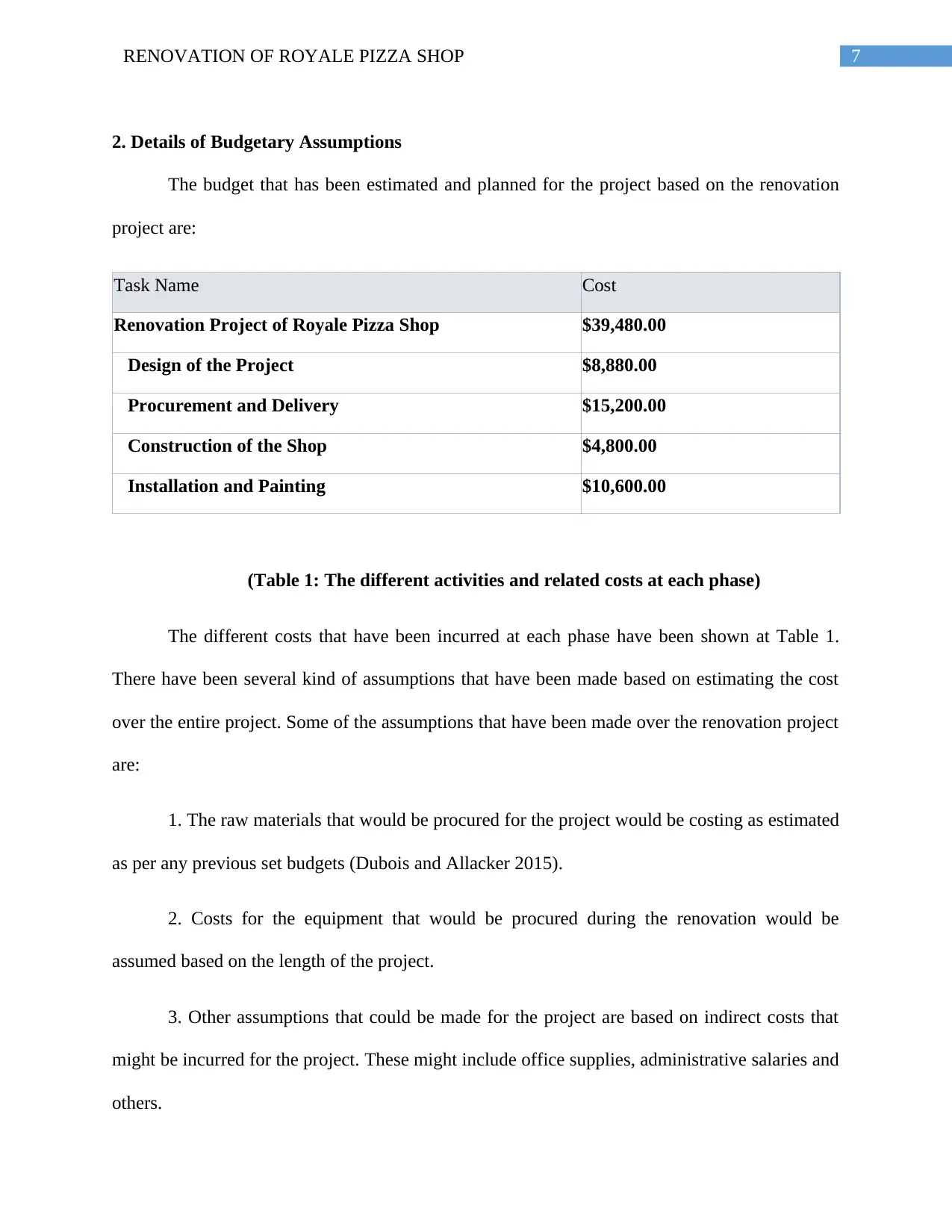
7RENOVATION OF ROYALE PIZZA SHOP
2. Details of Budgetary Assumptions
The budget that has been estimated and planned for the project based on the renovation
project are:
Task Name Cost
Renovation Project of Royale Pizza Shop $39,480.00
Design of the Project $8,880.00
Procurement and Delivery $15,200.00
Construction of the Shop $4,800.00
Installation and Painting $10,600.00
(Table 1: The different activities and related costs at each phase)
The different costs that have been incurred at each phase have been shown at Table 1.
There have been several kind of assumptions that have been made based on estimating the cost
over the entire project. Some of the assumptions that have been made over the renovation project
are:
1. The raw materials that would be procured for the project would be costing as estimated
as per any previous set budgets (Dubois and Allacker 2015).
2. Costs for the equipment that would be procured during the renovation would be
assumed based on the length of the project.
3. Other assumptions that could be made for the project are based on indirect costs that
might be incurred for the project. These might include office supplies, administrative salaries and
others.
2. Details of Budgetary Assumptions
The budget that has been estimated and planned for the project based on the renovation
project are:
Task Name Cost
Renovation Project of Royale Pizza Shop $39,480.00
Design of the Project $8,880.00
Procurement and Delivery $15,200.00
Construction of the Shop $4,800.00
Installation and Painting $10,600.00
(Table 1: The different activities and related costs at each phase)
The different costs that have been incurred at each phase have been shown at Table 1.
There have been several kind of assumptions that have been made based on estimating the cost
over the entire project. Some of the assumptions that have been made over the renovation project
are:
1. The raw materials that would be procured for the project would be costing as estimated
as per any previous set budgets (Dubois and Allacker 2015).
2. Costs for the equipment that would be procured during the renovation would be
assumed based on the length of the project.
3. Other assumptions that could be made for the project are based on indirect costs that
might be incurred for the project. These might include office supplies, administrative salaries and
others.

8RENOVATION OF ROYALE PIZZA SHOP
The project manager would be the primary person responsible for controlling the various
costs that get incurred for the project. Hence, the actions that needs to be taken based on
controlling the costs incurred for the project are:
1. They should make use of proper software based on keeping a monitoring over the real-
time updates over the project being designed (Harty, Themsen and Tryggestad 2014). A proper
software based on cost estimation would be highly required for measuring the estimated costs
against the cost being incurred at each phase of the project.
2. They should measure the size of the project before starting over the activities. Hence,
this would help in measuring the costs over the scheduled activities and resources that would be
required at each phase.
3. Unexpected costs could arise within the project at any time under any circumstances.
Certain prices of raw materials being procured might arise, which might exceed the overall
estimated budget for procurement (Ter Bogt, Van Helden and Van Der Kolk 2015). Hence, some
additional costs should be supported and kept in hand in order to cover up any additional costs.
4. Inflation rates might increase for the raw materials being procured (Pikas et al. 2015).
Hence, the project manager should be aware of such scenarios and thus notify the shop owners
and shop supervisors based on providing additional budget whenever needed.
The project manager would be the primary person responsible for controlling the various
costs that get incurred for the project. Hence, the actions that needs to be taken based on
controlling the costs incurred for the project are:
1. They should make use of proper software based on keeping a monitoring over the real-
time updates over the project being designed (Harty, Themsen and Tryggestad 2014). A proper
software based on cost estimation would be highly required for measuring the estimated costs
against the cost being incurred at each phase of the project.
2. They should measure the size of the project before starting over the activities. Hence,
this would help in measuring the costs over the scheduled activities and resources that would be
required at each phase.
3. Unexpected costs could arise within the project at any time under any circumstances.
Certain prices of raw materials being procured might arise, which might exceed the overall
estimated budget for procurement (Ter Bogt, Van Helden and Van Der Kolk 2015). Hence, some
additional costs should be supported and kept in hand in order to cover up any additional costs.
4. Inflation rates might increase for the raw materials being procured (Pikas et al. 2015).
Hence, the project manager should be aware of such scenarios and thus notify the shop owners
and shop supervisors based on providing additional budget whenever needed.
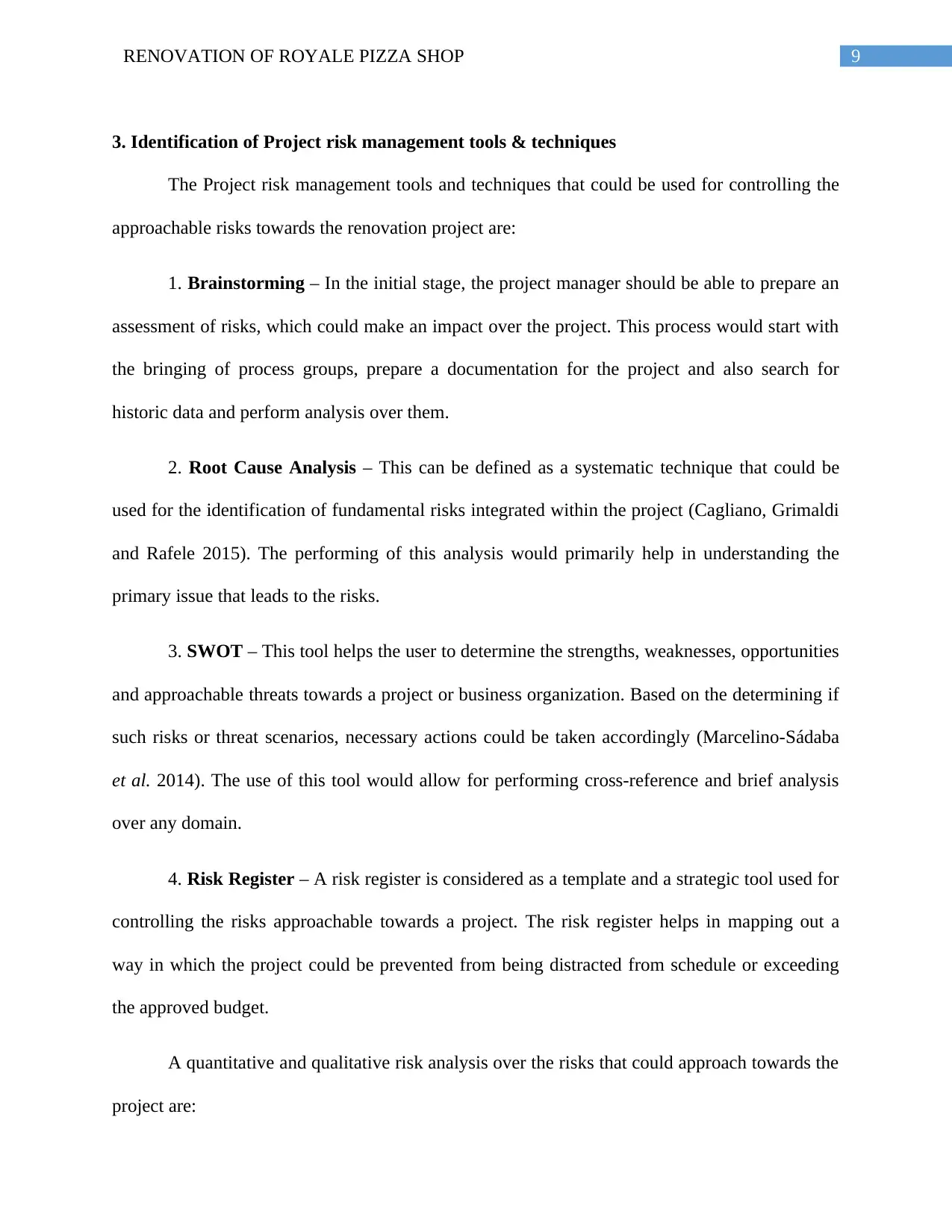
9RENOVATION OF ROYALE PIZZA SHOP
3. Identification of Project risk management tools & techniques
The Project risk management tools and techniques that could be used for controlling the
approachable risks towards the renovation project are:
1. Brainstorming – In the initial stage, the project manager should be able to prepare an
assessment of risks, which could make an impact over the project. This process would start with
the bringing of process groups, prepare a documentation for the project and also search for
historic data and perform analysis over them.
2. Root Cause Analysis – This can be defined as a systematic technique that could be
used for the identification of fundamental risks integrated within the project (Cagliano, Grimaldi
and Rafele 2015). The performing of this analysis would primarily help in understanding the
primary issue that leads to the risks.
3. SWOT – This tool helps the user to determine the strengths, weaknesses, opportunities
and approachable threats towards a project or business organization. Based on the determining if
such risks or threat scenarios, necessary actions could be taken accordingly (Marcelino-Sádaba
et al. 2014). The use of this tool would allow for performing cross-reference and brief analysis
over any domain.
4. Risk Register – A risk register is considered as a template and a strategic tool used for
controlling the risks approachable towards a project. The risk register helps in mapping out a
way in which the project could be prevented from being distracted from schedule or exceeding
the approved budget.
A quantitative and qualitative risk analysis over the risks that could approach towards the
project are:
3. Identification of Project risk management tools & techniques
The Project risk management tools and techniques that could be used for controlling the
approachable risks towards the renovation project are:
1. Brainstorming – In the initial stage, the project manager should be able to prepare an
assessment of risks, which could make an impact over the project. This process would start with
the bringing of process groups, prepare a documentation for the project and also search for
historic data and perform analysis over them.
2. Root Cause Analysis – This can be defined as a systematic technique that could be
used for the identification of fundamental risks integrated within the project (Cagliano, Grimaldi
and Rafele 2015). The performing of this analysis would primarily help in understanding the
primary issue that leads to the risks.
3. SWOT – This tool helps the user to determine the strengths, weaknesses, opportunities
and approachable threats towards a project or business organization. Based on the determining if
such risks or threat scenarios, necessary actions could be taken accordingly (Marcelino-Sádaba
et al. 2014). The use of this tool would allow for performing cross-reference and brief analysis
over any domain.
4. Risk Register – A risk register is considered as a template and a strategic tool used for
controlling the risks approachable towards a project. The risk register helps in mapping out a
way in which the project could be prevented from being distracted from schedule or exceeding
the approved budget.
A quantitative and qualitative risk analysis over the risks that could approach towards the
project are:
Paraphrase This Document
Need a fresh take? Get an instant paraphrase of this document with our AI Paraphraser
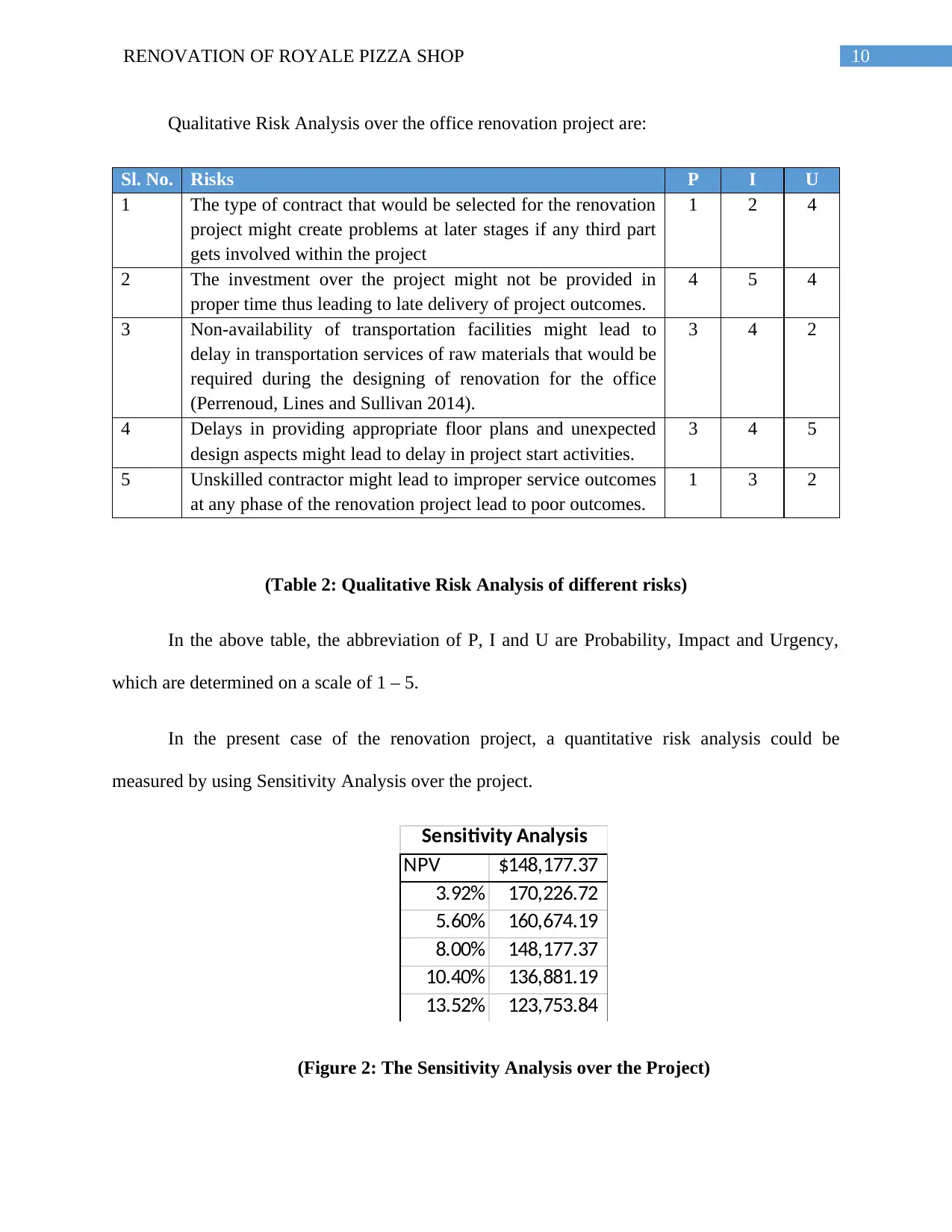
10RENOVATION OF ROYALE PIZZA SHOP
Qualitative Risk Analysis over the office renovation project are:
Sl. No. Risks P I U
1 The type of contract that would be selected for the renovation
project might create problems at later stages if any third part
gets involved within the project
1 2 4
2 The investment over the project might not be provided in
proper time thus leading to late delivery of project outcomes.
4 5 4
3 Non-availability of transportation facilities might lead to
delay in transportation services of raw materials that would be
required during the designing of renovation for the office
(Perrenoud, Lines and Sullivan 2014).
3 4 2
4 Delays in providing appropriate floor plans and unexpected
design aspects might lead to delay in project start activities.
3 4 5
5 Unskilled contractor might lead to improper service outcomes
at any phase of the renovation project lead to poor outcomes.
1 3 2
(Table 2: Qualitative Risk Analysis of different risks)
In the above table, the abbreviation of P, I and U are Probability, Impact and Urgency,
which are determined on a scale of 1 – 5.
In the present case of the renovation project, a quantitative risk analysis could be
measured by using Sensitivity Analysis over the project.
NPV $148,177.37
3.92% 170,226.72
5.60% 160,674.19
8.00% 148,177.37
10.40% 136,881.19
13.52% 123,753.84
Sensitivity Analysis
(Figure 2: The Sensitivity Analysis over the Project)
Qualitative Risk Analysis over the office renovation project are:
Sl. No. Risks P I U
1 The type of contract that would be selected for the renovation
project might create problems at later stages if any third part
gets involved within the project
1 2 4
2 The investment over the project might not be provided in
proper time thus leading to late delivery of project outcomes.
4 5 4
3 Non-availability of transportation facilities might lead to
delay in transportation services of raw materials that would be
required during the designing of renovation for the office
(Perrenoud, Lines and Sullivan 2014).
3 4 2
4 Delays in providing appropriate floor plans and unexpected
design aspects might lead to delay in project start activities.
3 4 5
5 Unskilled contractor might lead to improper service outcomes
at any phase of the renovation project lead to poor outcomes.
1 3 2
(Table 2: Qualitative Risk Analysis of different risks)
In the above table, the abbreviation of P, I and U are Probability, Impact and Urgency,
which are determined on a scale of 1 – 5.
In the present case of the renovation project, a quantitative risk analysis could be
measured by using Sensitivity Analysis over the project.
NPV $148,177.37
3.92% 170,226.72
5.60% 160,674.19
8.00% 148,177.37
10.40% 136,881.19
13.52% 123,753.84
Sensitivity Analysis
(Figure 2: The Sensitivity Analysis over the Project)

11RENOVATION OF ROYALE PIZZA SHOP
(Source: Created by author)
From the analysis over the above picture, it can be understood that the NPV of the project
is $148,177.37 when the interest rate is 8%. It can be summarized when the percentage of
interest would fall till 3.92%, the NPV would be $170,226.72. However, whenever the interest
rate would rise till 13.52%, the NPV would be $123.753.84. This number is based on a positive
number, which indicates that the project is considered as feasible. It would further mean that
despite of the present risks within the project, it would be feasible for performing the project.
Based on the discussed risks, some of the risk response strategies and techniques that
could be used are:
1. Avoidance
2. Acceptance
3. Prepare and Monitor (Zhang 2016)
4. Mitigation
5. Transference
(Source: Created by author)
From the analysis over the above picture, it can be understood that the NPV of the project
is $148,177.37 when the interest rate is 8%. It can be summarized when the percentage of
interest would fall till 3.92%, the NPV would be $170,226.72. However, whenever the interest
rate would rise till 13.52%, the NPV would be $123.753.84. This number is based on a positive
number, which indicates that the project is considered as feasible. It would further mean that
despite of the present risks within the project, it would be feasible for performing the project.
Based on the discussed risks, some of the risk response strategies and techniques that
could be used are:
1. Avoidance
2. Acceptance
3. Prepare and Monitor (Zhang 2016)
4. Mitigation
5. Transference
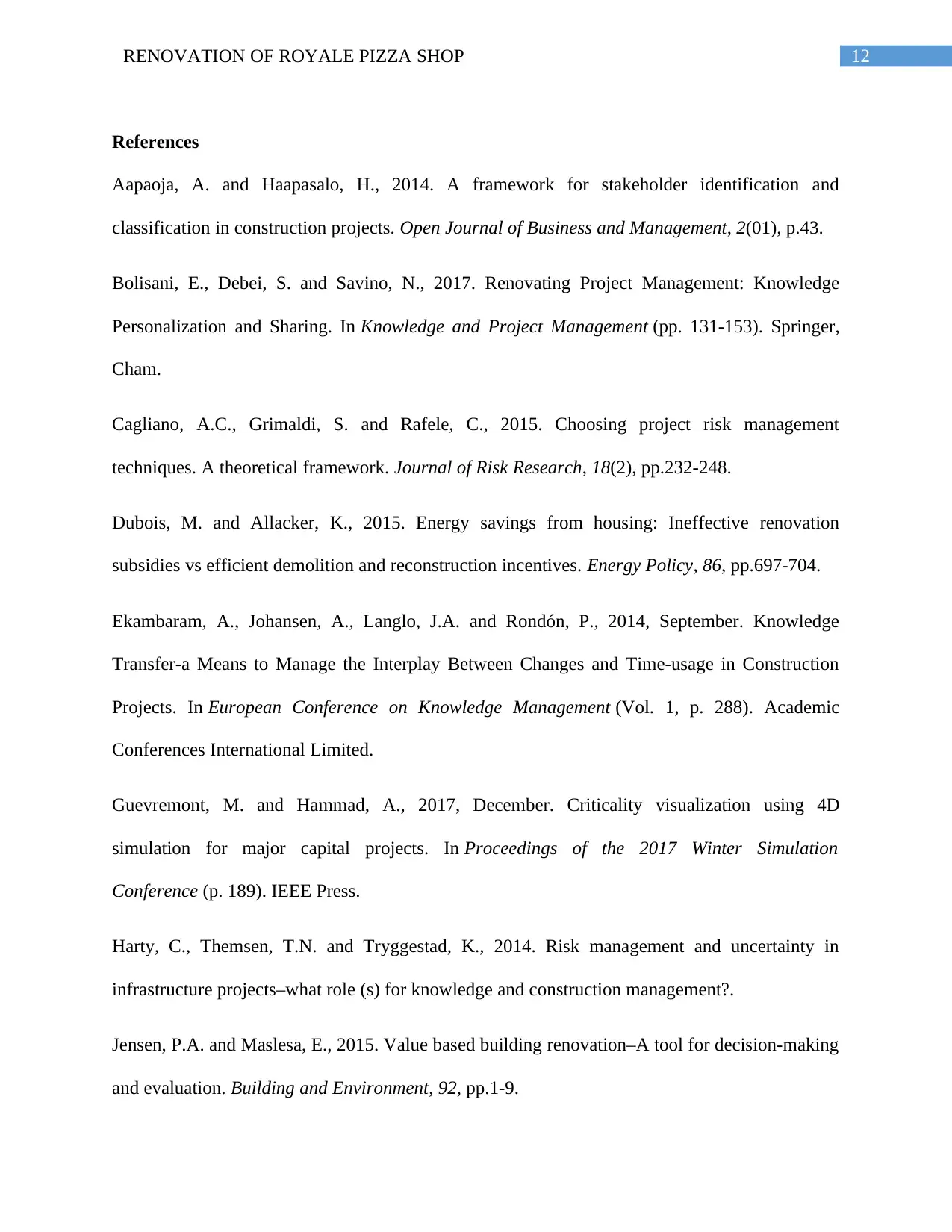
12RENOVATION OF ROYALE PIZZA SHOP
References
Aapaoja, A. and Haapasalo, H., 2014. A framework for stakeholder identification and
classification in construction projects. Open Journal of Business and Management, 2(01), p.43.
Bolisani, E., Debei, S. and Savino, N., 2017. Renovating Project Management: Knowledge
Personalization and Sharing. In Knowledge and Project Management (pp. 131-153). Springer,
Cham.
Cagliano, A.C., Grimaldi, S. and Rafele, C., 2015. Choosing project risk management
techniques. A theoretical framework. Journal of Risk Research, 18(2), pp.232-248.
Dubois, M. and Allacker, K., 2015. Energy savings from housing: Ineffective renovation
subsidies vs efficient demolition and reconstruction incentives. Energy Policy, 86, pp.697-704.
Ekambaram, A., Johansen, A., Langlo, J.A. and Rondón, P., 2014, September. Knowledge
Transfer-a Means to Manage the Interplay Between Changes and Time-usage in Construction
Projects. In European Conference on Knowledge Management (Vol. 1, p. 288). Academic
Conferences International Limited.
Guevremont, M. and Hammad, A., 2017, December. Criticality visualization using 4D
simulation for major capital projects. In Proceedings of the 2017 Winter Simulation
Conference (p. 189). IEEE Press.
Harty, C., Themsen, T.N. and Tryggestad, K., 2014. Risk management and uncertainty in
infrastructure projects–what role (s) for knowledge and construction management?.
Jensen, P.A. and Maslesa, E., 2015. Value based building renovation–A tool for decision-making
and evaluation. Building and Environment, 92, pp.1-9.
References
Aapaoja, A. and Haapasalo, H., 2014. A framework for stakeholder identification and
classification in construction projects. Open Journal of Business and Management, 2(01), p.43.
Bolisani, E., Debei, S. and Savino, N., 2017. Renovating Project Management: Knowledge
Personalization and Sharing. In Knowledge and Project Management (pp. 131-153). Springer,
Cham.
Cagliano, A.C., Grimaldi, S. and Rafele, C., 2015. Choosing project risk management
techniques. A theoretical framework. Journal of Risk Research, 18(2), pp.232-248.
Dubois, M. and Allacker, K., 2015. Energy savings from housing: Ineffective renovation
subsidies vs efficient demolition and reconstruction incentives. Energy Policy, 86, pp.697-704.
Ekambaram, A., Johansen, A., Langlo, J.A. and Rondón, P., 2014, September. Knowledge
Transfer-a Means to Manage the Interplay Between Changes and Time-usage in Construction
Projects. In European Conference on Knowledge Management (Vol. 1, p. 288). Academic
Conferences International Limited.
Guevremont, M. and Hammad, A., 2017, December. Criticality visualization using 4D
simulation for major capital projects. In Proceedings of the 2017 Winter Simulation
Conference (p. 189). IEEE Press.
Harty, C., Themsen, T.N. and Tryggestad, K., 2014. Risk management and uncertainty in
infrastructure projects–what role (s) for knowledge and construction management?.
Jensen, P.A. and Maslesa, E., 2015. Value based building renovation–A tool for decision-making
and evaluation. Building and Environment, 92, pp.1-9.
Secure Best Marks with AI Grader
Need help grading? Try our AI Grader for instant feedback on your assignments.
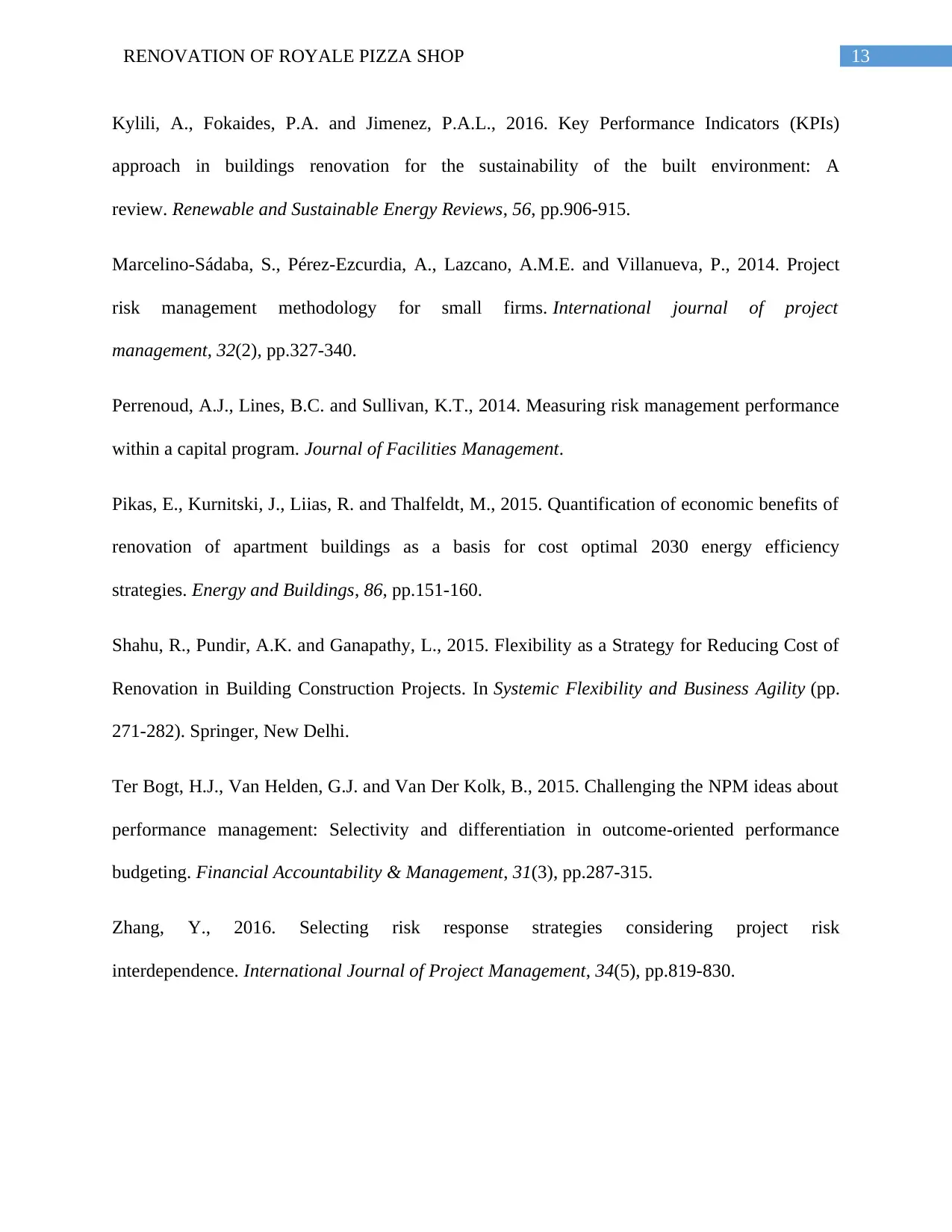
13RENOVATION OF ROYALE PIZZA SHOP
Kylili, A., Fokaides, P.A. and Jimenez, P.A.L., 2016. Key Performance Indicators (KPIs)
approach in buildings renovation for the sustainability of the built environment: A
review. Renewable and Sustainable Energy Reviews, 56, pp.906-915.
Marcelino-Sádaba, S., Pérez-Ezcurdia, A., Lazcano, A.M.E. and Villanueva, P., 2014. Project
risk management methodology for small firms. International journal of project
management, 32(2), pp.327-340.
Perrenoud, A.J., Lines, B.C. and Sullivan, K.T., 2014. Measuring risk management performance
within a capital program. Journal of Facilities Management.
Pikas, E., Kurnitski, J., Liias, R. and Thalfeldt, M., 2015. Quantification of economic benefits of
renovation of apartment buildings as a basis for cost optimal 2030 energy efficiency
strategies. Energy and Buildings, 86, pp.151-160.
Shahu, R., Pundir, A.K. and Ganapathy, L., 2015. Flexibility as a Strategy for Reducing Cost of
Renovation in Building Construction Projects. In Systemic Flexibility and Business Agility (pp.
271-282). Springer, New Delhi.
Ter Bogt, H.J., Van Helden, G.J. and Van Der Kolk, B., 2015. Challenging the NPM ideas about
performance management: Selectivity and differentiation in outcome‐oriented performance
budgeting. Financial Accountability & Management, 31(3), pp.287-315.
Zhang, Y., 2016. Selecting risk response strategies considering project risk
interdependence. International Journal of Project Management, 34(5), pp.819-830.
Kylili, A., Fokaides, P.A. and Jimenez, P.A.L., 2016. Key Performance Indicators (KPIs)
approach in buildings renovation for the sustainability of the built environment: A
review. Renewable and Sustainable Energy Reviews, 56, pp.906-915.
Marcelino-Sádaba, S., Pérez-Ezcurdia, A., Lazcano, A.M.E. and Villanueva, P., 2014. Project
risk management methodology for small firms. International journal of project
management, 32(2), pp.327-340.
Perrenoud, A.J., Lines, B.C. and Sullivan, K.T., 2014. Measuring risk management performance
within a capital program. Journal of Facilities Management.
Pikas, E., Kurnitski, J., Liias, R. and Thalfeldt, M., 2015. Quantification of economic benefits of
renovation of apartment buildings as a basis for cost optimal 2030 energy efficiency
strategies. Energy and Buildings, 86, pp.151-160.
Shahu, R., Pundir, A.K. and Ganapathy, L., 2015. Flexibility as a Strategy for Reducing Cost of
Renovation in Building Construction Projects. In Systemic Flexibility and Business Agility (pp.
271-282). Springer, New Delhi.
Ter Bogt, H.J., Van Helden, G.J. and Van Der Kolk, B., 2015. Challenging the NPM ideas about
performance management: Selectivity and differentiation in outcome‐oriented performance
budgeting. Financial Accountability & Management, 31(3), pp.287-315.
Zhang, Y., 2016. Selecting risk response strategies considering project risk
interdependence. International Journal of Project Management, 34(5), pp.819-830.
1 out of 14
Related Documents
Your All-in-One AI-Powered Toolkit for Academic Success.
+13062052269
info@desklib.com
Available 24*7 on WhatsApp / Email
![[object Object]](/_next/static/media/star-bottom.7253800d.svg)
Unlock your academic potential
© 2024 | Zucol Services PVT LTD | All rights reserved.




